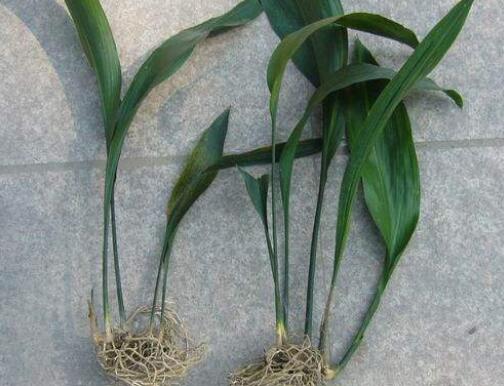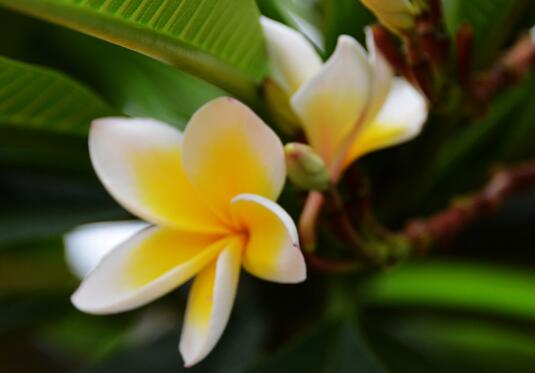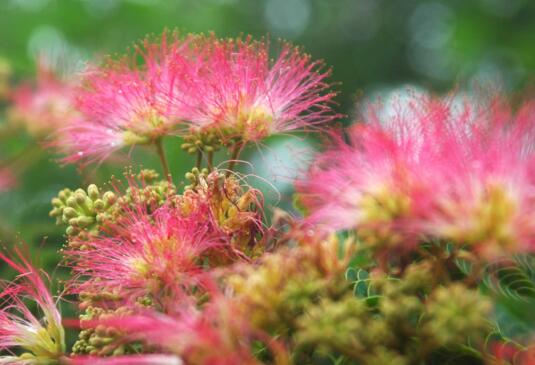How to propagate one-leaf orchid, propagation methods / post-breeding maintenance skills of one-leaf orchid
One-leaf orchid is extremely shade-tolerant, which makes it the most popular indoor foliage plant. It is not only easy to grow, but also very simple to reproduce, so how can one-leaf orchid reproduce and survive easily? That is ramet, let's learn more about the propagation method of planting one-leaf orchid.
How does one-leaf orchid reproduce?

When most plants propagate, there will be ramet, cuttage, sowing, tissue culture, and so on. The first two are simple and low in technical requirements, so they are used the most, so the one-leaf orchid propagation method generally uses ramets. When using ramet, how to propagate one-leaf orchid? The main points are as follows.
The Propagation method of Cymbidium
1. Ramet time of Cymbidium mongolica
The time is generally chosen from February to March, when the temperature begins to rise, the soil slowly thaws, and new buds are about to sprout, and ramets should be chosen before sprouting, so February-March is the most suitable, and then affect the speed of growth recovery after reproduction.
2. Ramet technique of Cymbidium mongolica.
Tap the outside of the basin to separate the soil, remove the mother plant from the basin together with the soil, clean up the excess soil and retain the root soil. The root of the knotted together is divided into several clumps with a knife, each keeping 2-3 plants.
Prune the separated seeds properly, retain 3-5 new leaves, then cut off other redundant branches and leaves, cut off the rotten roots at the same time, and then leave them in a cool place, which is a detail that can not be ignored in the breeding method of Cymbidium.
3. Planting in pots
Replant the sub-plant in the prepared basin soil, in this process, need to disinfect the sub-plant, if it is disinfected before planting, soak the sub-strain in 1500 times chlorothalonil solution for 5 minutes; if it is disinfected after door-to-door, you can fill the root with chlorothalonil 1500 solution.
Maintenance of Cymbidium after Propagation
1. Pour the water thoroughly after filling the basin.
Watering is needed after the basin is installed, and this watering is very important for the orchid, because the root of the mother plant will be damaged to a certain extent in the process of separation, and its water absorption capacity will be weakened, so it is necessary to ensure that enough water is conducive to rooting. After watering, we need to look at the wetness of the soil, and the method can refer to the detailed introduction of how to water the orchid.
2. Spray the foliar surface
Because the ability of the root to absorb water is limited, in order to maintain the water balance of the leaves, it is necessary to spray the leaves about 1-3 times a day, and if it is a place with higher temperature, the times are slightly more. Keeping a high humidity is conducive to the germination of new leaves.
3. Stop fertilization
If you use the ramet in the propagation method of one-leaf orchid, you must stop fertilizing during the breeding period, and you can apply base fertilizer at the bottom of the soil during the breeding period, but do not apply fertilizer again after potting, because the root system needs a period of time to adapt at this time. Fertilization may cause fertilizer damage.
4. Keep it in a cool place
After installing the pot, the one-leaf orchid should be preserved in a cool base fertilizer, rather than in the sun. It can take root in 3-4 weeks. If it is in the sun, it may delay, and even affect the survival of the offspring after breeding.
How to propagate one-leaf orchid and how to reproduce one-leaf orchid.
One-leaf orchid can be propagated by ramet, and it is not difficult to operate one-leaf orchid. The following steps are sorted out to help flower friends to better reproduce one-leaf orchid.
The method of split propagation of one-leaf orchid 1. Ramet time
The split time of one-leaf orchid can be selected when the temperature rises in spring, and it can be combined with changing pots, from February to March.
3. Detached ramets
First of all, the mother plant of the leaf orchid should be taken out of the flowerpot, and the excess pot soil should be shaken off at the same time. In addition, the flower friends should separate the root system as much as possible, and then cut the leaf orchid open with a sharp knife and divide it into two or more plants.
Remember that each separate plant must have roots, and at the same time, the leaves of the separated plants need to be pruned properly to make each clump with 3 to 5 leaves, which is more conducive to survival.
2. Plant disinfection
Soak the split plant in 1500 times chlorothalonil solution for about five minutes, then take it out and dry it, and then plant it in a pot.
4. Maintenance after plant division
After the one-leaf orchid is potted, the root is irrigated or watered once. Because the root system of the one-leaf orchid is greatly damaged and its water absorption capacity is very weak, it takes about 3-4 weeks to recover the new roots. Therefore, controlled watering is needed within 3-4 weeks after the ramet, so as to avoid rotting roots.
In order to maintain the water balance of the leaves, flower friends are advised to spray the leaves one or three times a day, spray more if the ambient temperature is high, spray less or not if the temperature is low.
In addition, do not fertilize during this period of time, and do not have too strong light at the same time, just keep it in the shade shed.
The Propagation method of how to raise Cymbidium in potted plants
One leaf orchid is also called spider holding egg, bamboo leaf plate, Kowloon plate and so on. it is a perennial evergreen persistent herb of Liliaceae. Its rhizome is nearly cylindrical and is mainly distributed in various provinces and regions in southern China, as well as Hainan Island and Taiwan Island. it is suitable for family and office layout, and can be watched alone or in cooperation with other flowering plants. Let's take a look at how to grow a potted orchid.
The farmed species of Cymbidium
1. Variegated leaf: spotted leaf orchid alias sprinkled golden spider egg, spotted leaf spider egg, star spot spider egg, etc., it is a cultivated variety of one-leaf orchid, and there are milky white or light yellow spots on the green leaves.
2. Golden thread: Golden leaf orchid alias golden spider holding egg, white spider holding egg, etc., is a cultivated variety of one-leaf orchid, with light yellow vertical lines on the green leaves.
The Propagation method of Cymbidium
1. Ramet time: the ramet propagation of Cymbidium can be carried out in combination with changing pots before the temperature rises in spring and before the new buds germinate, usually after the soil is thawed in early spring (February and March).
2. Split method: take the mother plant out of the flowerpot, shake off the excess potted soil, separate the root system as much as possible, and cut it into two or more plants with a sharp knife. Each plant should have a considerable root system, and its leaves should be pruned properly to make each clump with 3 to 5 leaves, in order to survive.
3. Disinfection in a basin: soak the divided plants in 1500 times chlorothalonil solution for five minutes, then take out and dry, and then put on the basin. You can also irrigate the root with chlorothalonil immediately after potting.
4. Ramet management: the ramet is irrigated or watered once after potting. Because the root system is greatly damaged and the water absorption capacity is very weak, it takes about 3-4 weeks to restore the new root germination, so it should be watered within 3-4 weeks to avoid rotting roots. However, the transpiration of its leaves is not affected. In order to maintain the water balance of the leaves, it is necessary to spray the leaves 1 or 3 times a day. After ramet, we should also pay attention to the excessive sunlight, it is best to keep it in the shade shed.
How to grow a potted orchid?
1. Soil: one-leaf orchid is barren, and the requirement for soil quality is not high, but it is better to be a slightly acidic sandy soil with ventilation and drainage. Shallow pots are used in pots, and the soil can be mixed with peat soil, broken bricks, perlite, charcoal and so on.
2. Temperature: the orchid is mainly in a warm environment, and the temperature is controlled between 7-30 ℃. In summer, the temperature is moved to a ventilated and semi-shaded place or covered by a shade. The winter temperature should not be lower than 0 ℃, generally 0-3 ℃.
3. Light: the orchid is negative-tolerant, and the dark environment can maintain its posture for a long time, but it is best to receive sunlight regularly to store the development and growth of its new buds, and try not to put it in a dark place during the growth period of new leaves. Summer can not be exposed to strong light, observe the status of yellow leaves even if the treatment, winter should be moved indoors, appropriate warmth.
4. Watering: a leaf orchid is usually watered with clean water. during the vigorous growth period, it is necessary to provide enough water, fully moisturize, properly spray the leaves to promote sprouting, there is no need for frequent watering after the end of autumn, and warm water can be sprayed to the leaves in winter. clean and maintain good posture.
5. Fertilization: one-leaf orchid is applied liquid fertilizer once or twice a month during spring and summer, and there is no need for fertilization in winter. In view of the scorch phenomenon caused by excessive drought, rarefied liquid fertilizer should be applied once or twice a month to make the leaves beautiful. Variegated varieties need to apply a small amount of fertilizer to prevent the spots from disappearing gradually.
Disease and insect control of Cymbidium chinense
1. Anthrax
[symptoms] the disease spots on the leaves of a leaf orchid often occur on the leaf edge or leaf surface. The lesion is nearly round, grayish white to grayish brown, the outer edge is yellowish brown or reddish brown, and there are small black dots arranged in a wheel in the later stage. In addition to leaves, petioles and stems are also infected, resulting in long streak spots. The pathogen overwinters in the soil or on diseased leaf tissue. Spread by airflow or water to carry out primary infection and re-infection. There are 2-3 peaks in the south and only one in the north. Continuous rainfall, heavy rainfall, serious disease.
[prevention and treatment] ① found diseased leaves and cut off and burned them in time to reduce the source of infection. Before the onset of the ② rainy season, spray 50% Shi Baig or Baogong wettable powder 1000 times liquid, 25% carbon tetralin wettable powder liquid. Once every 10 days, prevention and control 3 times 4 times. Spraying 0.5% potassium dihydrogen phosphate or 300 times of double-effect micro-fertilizer when necessary by ③ is beneficial to enhance disease resistance.
2. Grey mold
[symptoms] often occur at the edge of the leaf. Waterlogged disease spots began to appear from the leaf edge, and the disease spots expanded rapidly when the humidity was high, resulting in irregular withering of the leaf margin, and generally no gray mildew layer was seen. But after continuous overcast and rain, the humidity is high, the duration is long, and sparse gray mold can grow. Botrytis cinerea uses hyphae to rot in the remains of the disease, and constantly produces conidia for re-infection. The survival time of sclerotia is long, if there are suitable conditions, hyphae grow, directly invade or sputter by Rain Water or spread with disease remains, water flow, farm tools and so on. The disease is easy to spread under the condition of high humidity and temperature of about 20 ℃.
[prevention] ① is carefully maintained. Choose the semi-shade environment with moist and good drainage. Cymbidium is a shade-tolerant plant, the light should not be too strong, otherwise it will cause leaf yellowing or disease. Too much irrigation, especially in winter, can lead to root rot and leaf yellowing. If sporadic diseased plants are found in ②, 65% metformin wettable powder 1000 times or 50% Sukeling wettable powder 1500 times, 50% Prohydantoin wettable powder and 50% Nongliling wettable powder 1000 times can be sprayed. The leaf orchid maintained by ③ in the greenhouse can increase the night temperature of the greenhouse, increase the ventilation time during the day, and reduce the humidity and fog duration in the greenhouse, so as to achieve the purpose of disease control.
3. Leaf spot
[symptoms] Leaf spot is also known as black spot, brown spot and so on. First of all, black spots appear in the middle of the leaves, and then the leaves turn yellow and fall off. The causes are mostly caused by muggy, unventilated and humid environment.
[prevention and control] pay attention to improving the environmental conditions, the damaged leaves can be removed and burned at the beginning of the disease. It can be sprayed with 1% Bordeaux solution, once every 7 days, for a total of 4 times during the whole growing period, or 1000 times with 50% carbendazim.
4. Scale insects
[symptoms] poor ventilation is easy to occur in summer, which mainly harms the stems and leaves of one-leaf orchid.
[prevention and treatment] it should be ventilated and transparent for a long time to reduce the incidence of disease. if shell insects are found to be harmful, iron should be applied to the root in time. Generally speaking, flowerpots with a caliber of 20 cm should be watered in time after burying 5% of domestic Tiemike 3-5 grams in each pot. It will be effective in 1 week.
- Prev

How to reproduce egg flower, the propagation method of egg flower / sowing / cutting / grafting / striping
Egg flower is a kind of highly ornamental plant, which is farmed in many areas of our country. With the increase of breeding people, people are more concerned about its reproduction. How to reproduce egg flower? What are the breeding methods of egg blossoms? Next, the editor will take you to learn about it.
- Next

How to breed albizia flower, how to breed albizia flower/sowing propagation/cutting propagation
Albizia flower is a kind of ornamental flower plant, in many areas of our country there are people in culture, with the cultivation of more people, about its reproduction also let people more concerned about how albizia flower reproduction? What are the breeding methods of Albizia flowers? The following small series takes everyone to understand
Related
- Fuxing push coffee new agricultural production and marketing class: lack of small-scale processing plants
- Jujube rice field leisure farm deep ploughing Yilan for five years to create a space for organic food and play
- Nongyu Farm-A trial of organic papaya for brave women with advanced technology
- Four points for attention in the prevention and control of diseases and insect pests of edible fungi
- How to add nutrient solution to Edible Fungi
- Is there any good way to control edible fungus mites?
- Open Inoculation Technology of Edible Fungi
- Is there any clever way to use fertilizer for edible fungus in winter?
- What agents are used to kill the pathogens of edible fungi in the mushroom shed?
- Rapid drying of Edible Fungi

